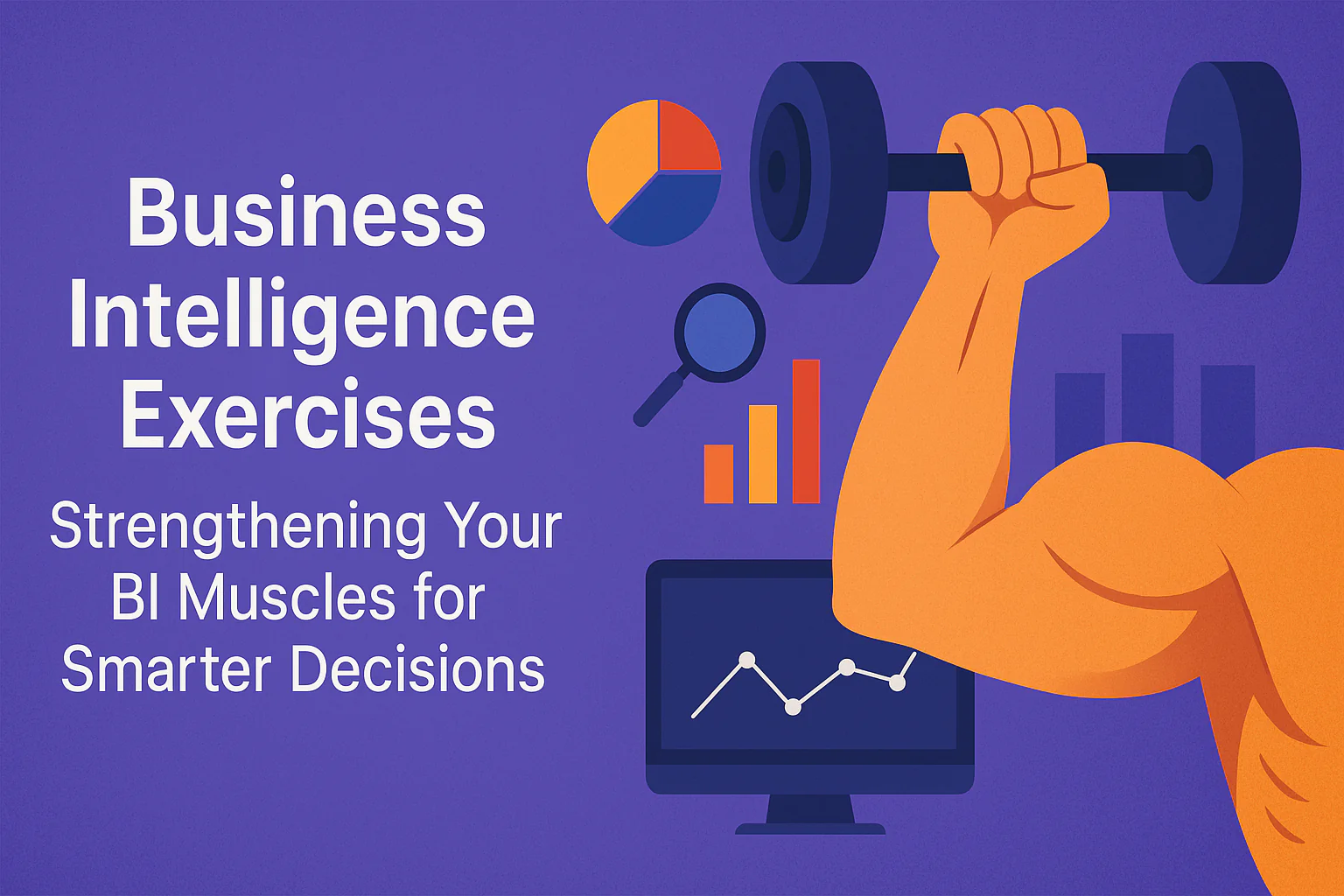In today’s modern society filled with technological advancements, having a solid foundation in business intelligence helps a company analyze metrics, identify areas for improvement, understand efficiency benchmarks, and even project future actions. Succeeding in business intelligence mastery, however, is not focused on tools alone, but demands a consistent approach towards its strategic exercises. This is where business intelligence exercises come in.
Practicing focused and intelligent business exercises aids in building a person’s skills towards data evaluation, data presentation, and even drafting reports. In this article, you shall find a collection of targeted exercises that, no matter where you stand on the business intelligence proficiency spectrum, will help you become more business savvy.
Table of Contents
What is Business Intelligence?
Understanding the exercises requires a person first to grasp business intelligence. BI encompasses the collection, integration, analysis, and presentation of business data with the relevant technologies, applications, and processes. BI exists to correct information gaps in a company.
Organizations can eliminate tedious manual data analysis and gain actionable insights by utilizing BI tools and platforms, such as Power BI, Tableau, and Looker. This not only improves operations but also allows performance tracking, outcome forecasting, and the maintenance of a competitive edge over other organizations.
Why are Business Intelligence Exercises Useful?
Doing business intelligence exercises is like working out at the gym. A workout routine greatly strengthens one’s physical capabilities. Without enough practice, however, one’s familiarity and ability with BI tools will decline.
Doing regular BI exercises will enable you to:
- Understand different sources of data
- Enhance data preparation and cleaning skills
- Master dashboards and data visualizations
- Enhance data storytelling skills
- Boost confidence in making informed decisions
- Stay informed on developments in BI tools and trends
In the next section, we will explore exercises aimed at advancing your skills as a BI professional.
1. Exercises on Data Preparation and Cleansing
Raw data requires cleansing to correct errors, missing values, and incorrectly recorded numbers. One of the most foundational business intelligence skills is to clean and prepare data for analysis.
Sample Exercises:
Obtain data from places like Kaggle or Data.gov. Pick one with missing values and inconsistent formats. Use Microsoft Excel, Power Query in Power BI, or even Python to clean the dataset.
Pay attention to:
- Removing duplicates
- Addressing missing data
- Standardizing date formats
- Creating new calculated columns
Mastering this exercise will enable you to appreciate the importance of accuracy during data cleansing in the analytics or visualization phase, before you delve deeper into the BI world.
2. Constructing Your Dashboards
Dashboards summarize and visualize the data regarding the performance of your business. Having the right dashboard in place can help your stakeholders identify and act on important business insights.
Exercise Example:
Consider a sample dataset such as e-commerce sales or HR data. With Power BI, Tableau, or Google Data Studio, create a dashboard that features important metrics such as revenue, conversion rates, employee attrition, or customer satisfaction.
Try to:
- Incorporate different chart types such as bar, line, and pie, or even a map.
- Incorporate slicers and filters.
- Add dynamic visualizations.
- Use conditional formatting.
Completing this exercise will help you improve your visual communication skills, which is an important asset in BI.
3. Data Modeling Scenarios
In business intelligence systems, data modeling is an important core component. Efficient querying and reporting require an organized schema model.
Exercise Example:
Extract different data from multiple tables, such as orders, customers, and products, and create relations. Then, depending on the complexity, build a star or snowflake schema.
Use Power BI’s data model view or SQL Server Management Studio. Learn about:
- Primary and foreign keys.
- One-to-many relationships.
- Fact and dimension tables.
You will learn how to structure databases to enhance performance in BI tools.
4. SQL Query Challenges
In business intelligence, SQL (Structured Query Language) serves a vital role. It is crucial in extracting, transforming, and analyzing information and content from various database systems.
Exercise Example:
Join and filter multiple tables, and group and aggregate to meet the given questions for the SQL query challenges.
SQL Query Challenges have no limit. Test your SQL skills answering questions like:
- What is the average monthly revenue per region?
- Which products have the highest return rate?
- How has customer behavior changed over time?
You can find SQL challenges on business intelligence for free on LeetCode, HackerRank, and Mode Analytics.
5. Creating KPI (Key Performance Indicators) Score Cards
Biz and Data Analytics professionals rely on score indicators to track business performance. In implementing a scorecard, significant information can be monitored in one view, allowing one to monitor the goals.
Exercise Example:
Specify important KPIs for the given sections to monitor on the scorecard. Track description for the marketing sections like Click Through Rate, Bounce Rate, and Sales monitor Revenue and New customers. For HR track Turnover Rate and Time to Hire. Design a scorecard that follows on Excel, and works with Power BI or Tableau.
The aim is to track on scorecards KPIs that are:
- Measurable and significant to the business objectives,
- Be relevant to the aim of the company (red, yellow, green) performance level visualization.
- Comparison of periods provided
- Scorecards help track and monitor where executive decisions are made on data.
6. Data Visualization
The ability to create narratives together with visuals from raw information is a skill that can only be obtained and mastered if time is given to the complex skill of data visualization.
This skill, if mastered, can help give great insight to aid various companies and gain further opportunities.
Exercise Example:
Select a public data set, such as COVID-19 statistics or environmental data, and create a short presentation. Be sure to include:
- A hook (why this data matters)
- A structured flow (problem, insight, action)
- Visuals that support the story
- Clear takeaways
Your story can be presented with PowerPoint, Power BI video, or video presentations.
While practicing storytelling, you improve the art of communication. Moreover, the insights you present have a greater impact.
7. Predictive Analytics Practice Problems
Although traditional BI tools are historical, the new BI tools incorporate predictive analytics. The knowledge on how to develop a model is beneficial as an add-on to your arsenal.
Exercise Example:
With some software (Excel, Python, R, etc.), use regression functions to create a basic predictive model. What you can foretell:
- Future sales based on past trends
- Probability of Customer Churn
- Demand forecasting
Start with a simple linear regression or decision trees and move upwards. Having the slightest idea of predictive modeling makes your reserved business intelligence stronger.
8. Case Studies of the Real World
Reading and discussing real-world BI case studies may make it possible to understand how companies utilize information in real-life situations.
Exercise Example:
Choose a company, e.g., Amazon, Netflix, or Starbucks, and research how the company is employing BI tools. In your own words, write copy-triplicates in your style-making your own in your own words, copy-triplicates in your Pinocchio voices in your handsome style.
What equipment do they have?
- Data collection and processing: How they collect and process data
- What are the business issues that they address using BI
- Compare this with your projects and see what can be improved upon.
9. Creating Your Own BI Portfolio
Developing a personal portfolio is an ideal way to demonstrate your BI capabilities, as it allows you to combine your exercises and projects.
Class Project Example:
- Put up for access via a blog or GitHub:
- SQL queries for databases
- Data dashboards and broadcasted data stories
- Predictive models tested and stories crafted around them
Your portfolio stands as your living CV and can actively draw employers and freelance work to you.
10. BI Simulation by Role
Business Intelligence is applied differently in each role. Completing targeted exercises for specific positions can provide a deeper understanding of BI in cross-functional areas.
Class Project Example:
Assume the role of a:
- Human Resource Analyst: Assess attrition
- Sales Manager: Review sales by region
- Marketing Analyst: Review the return on investment for advertising
- Operations Manager: Review the efficiency of supply chains and business processes
Spend time solving problems for specific departments using invented data and scenarios. This nurtures adaptability.
Business intelligence is much more than just dashboards and charts. Business intelligence involves data-driven decisions. Regular practice and exercises help build technical and analytical skills vital for the competitive business environment.
With systematic practice, mastery of the entire business intelligence (BI) pipeline is achieved, which includes data collection, cleaning, modeling, visualization, analysis, and storytelling. Anyone with an interest in data, whether a student or a professional with career aspirations in BI, needs to practice consistently.
Pick one exercise to complete for the week, and commit to it. Start small, and over time, skills and confidence combined with the ability to make better, data-driven decisions will increase dramatically.
Conclusion
When it comes to business intelligence, dashboards and charts are not everything; it is about making decisions with data. In performing business intelligence activities regularly, you develop skills much more than in technology, but also in the mental attitude critical to providing success in the modern competitive business world.
These activities will make you a master of the entire BI process: gathering, cleaning, modeling, visualizing, analyzing, and telling stories. You can be a student or simply passionate about data, or a professional who wants a BI career, but the same way to progress in this area is to practice regularly.
Therefore, begin with little. Pick one exercise that you can stick with during this week. After some time, you will feel confident and possess a high level of skill, and after some time, you will get so used to making smarter data-driven decisions.




